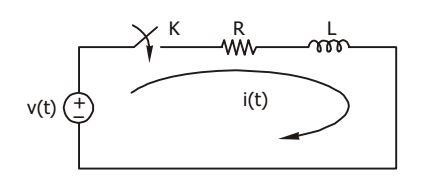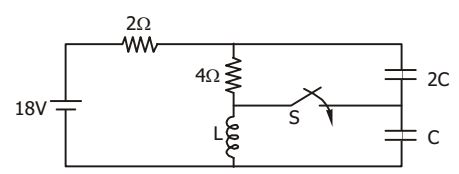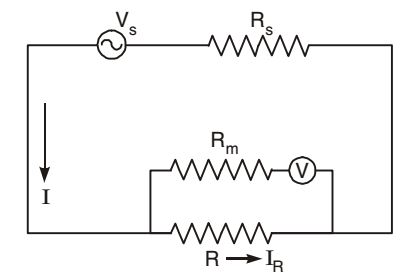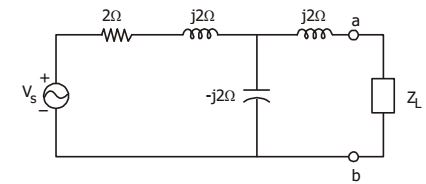Electric circuits miscellaneous
- In the circuit shown in the given figure, switch K is closed at t = 0. The circuit was initially relaxed. Which one of the following sources of v(t) will produce maximum current at t = 0+ ?

-
View Hint View Answer Discuss in Forum
For unit step source,
I(t) = V 
1 - e(-R / L)t 
R
At t = 0, I (t) = 0For ramp, inputI (t) I(t) = V 
tUt - 
1 - e(-R / L)t 

R
At t = 0, I(t) = 0For impulse input, I(t) = V e(-R / L)t R Then at t = 0, I(t) = V Maximum R
Correct Option: B
For unit step source,
I(t) = V 
1 - e(-R / L)t 
R
At t = 0, I (t) = 0For ramp, inputI (t) I(t) = V 
tUt - 
1 - e(-R / L)t 

R
At t = 0, I(t) = 0For impulse input, I(t) = V e(-R / L)t R Then at t = 0, I(t) = V Maximum R
- A battery charger can drive a current of 5 A into a 1 ohm resistance connected at its output teminals. If it is able to charge an ideal 2 V battery at 7 A rate, then its Thevenin’s equivalent will be
-
View Hint View Answer Discuss in Forum

From Fig. (a)
V = I (1 + r)
⇒ V = 5 (1 + r) ...(i)
From Fig. (b),
V – 2 = 7 r ...(ii)
Adding equations (i), and (ii), we get
V = 12 volts and, r = 1.5 ΩCorrect Option: B

From Fig. (a)
V = I (1 + r)
⇒ V = 5 (1 + r) ...(i)
From Fig. (b),
V – 2 = 7 r ...(ii)
Adding equations (i), and (ii), we get
V = 12 volts and, r = 1.5 Ω
- In the circuit shown in the given figure, steadystate was reached when the switch S was open. The switch was closed at t = 0. The initial value of the current through the capacitor 2C is 12 Amp

-
View Hint View Answer Discuss in Forum
Initial voltage on 2C = 12 volts
Then,discharging current, Id(t) = d 
2C.12 e(-t.3 / 8C) 
dt Then , Id(t) t = 0| = 
-24C × 3 . e(-t.3 / 8C) 
8C
= -9 ampNow, charging current, Ic(t) = d 
24C 
1 - e(-3t / 8C) 

dt
= -9 amp
At t = 0, Ic(t) = 9 amp.
Hence, at t = 0
total current I(t) = Ic(t) + Id(t) = 0 amp.
Correct Option: A
Initial voltage on 2C = 12 volts
Then,discharging current, Id(t) = d 
2C.12 e(-t.3 / 8C) 
dt Then , Id(t) t = 0| = 
-24C × 3 . e(-t.3 / 8C) 
8C
= -9 ampNow, charging current, Ic(t) = d 
24C 
1 - e(-3t / 8C) 

dt
= -9 amp
At t = 0, Ic(t) = 9 amp.
Hence, at t = 0
total current I(t) = Ic(t) + Id(t) = 0 amp.
- A resistor R is connected to a voltage source Vs having an internal resistance Rs . A voltmeter of resistance Rm is connected across the terminals of the resistor R. The voltmeter will read a voltage of
-
View Hint View Answer Discuss in Forum
The figure will be as drawn below :

Voltage measured across R = IR. R= R × I × Rm R + Rm = RRm × Vs R + Rm Rs + Rm R Rm + R = Vs.RRm RsR + RsRm + RRm Correct Option: D
The figure will be as drawn below :

Voltage measured across R = IR. R= R × I × Rm R + Rm = RRm × Vs R + Rm Rs + Rm R Rm + R = Vs.RRm RsR + RsRm + RRm
- Which one of the following impedance values of load will cause maximum power to be transferred to the load for the network shown in the given figure?

-
View Hint View Answer Discuss in Forum
ZTH (impedance looking left through terminal AB)
= 2j + (2 + 2j).(-2j) 2 + 2j - 2j
= 2j + 2 – 2j = 2Ω
For maximum power, ZTH = ZL
Correct Option: D
ZTH (impedance looking left through terminal AB)
= 2j + (2 + 2j).(-2j) 2 + 2j - 2j
= 2j + 2 – 2j = 2Ω
For maximum power, ZTH = ZL

